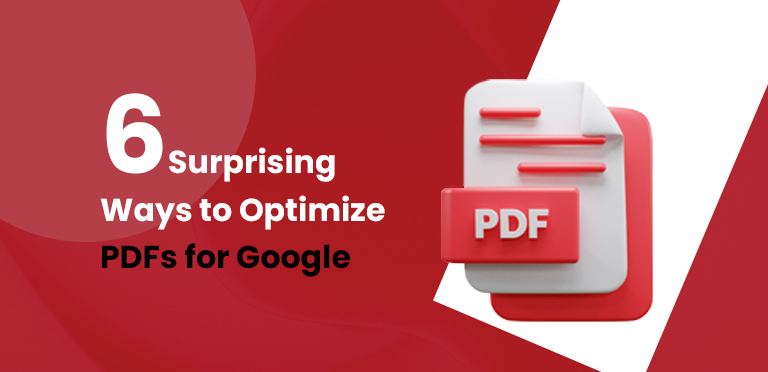6 Surprising Ways to Optimize PDFs for Google



Importance of SEO
Search engine optimization (SEO) is a crucial strategy for improving online visibility and driving organic traffic to websites. Marketers and website owners invest significant effort in optimizing web pages, blog posts, and images to ensure that their content ranks highly on search engine results pages (SERPs).
By following best practices, businesses can improve user experience, increase engagement, and generate more leads. However, many content creators tend to overlook other document formats that are equally important for SEO.
PDF Optimization as a Valuable Yet Underutilized SEO Strategy
One such underutilized file format is the PDF. PDFs are widely used for whitepapers, research reports, e-books, and guides. Since search engines can index PDFs, they present a valuable opportunity for improving visibility in search results. However, without proper search engine optimization, a PDF can become difficult for search engines to interpret, limiting their potential to rank well.
By applying strategic SEO techniques to these documents, businesses can enhance their accessibility, improve discoverability, and leverage them as an additional source of organic traffic.
In this guide, we will explore six surprising ways to optimize PDFs for Google. These techniques will help ensure that your PDFs rank higher and attract more visitors:
- Crafting Keyword-Rich File Names – How to name your PDFs for maximum SEO benefit.
- Utilizing Document Properties Effectively – The importance of optimizing metadata like title, author, and keywords.
- Structuring Content with Headings and Subheadings – Enhancing readability and SEO through proper PDF formatting.
- Incorporating Alt Text for Images – Making images within PDFs accessible to search engines.
- Ensuring Text-Based Content Over Image-Based Text – How to make your PDF content searchable and indexable.
- Implementing Internal and External Links – Strategies to improve SEO through effective linking.
1. Crafting Keyword-Rich File Names
Optimizing a PDF for search engines starts with a well-structured, keyword-rich file name. Search engines like Google consider file names as a ranking factor, meaning a descriptive, relevant title can enhance discoverability.
Instead of using a generic name such as “document123.pdf” or “file.pdf,” craft a filename that accurately represents the content while incorporating relevant search terms.
Best Practices for Naming PDFs for SEO:
- Use Primary Keywords: Identify the main keywords that summarize the document’s content. For instance, if the PDF is a guide on SEO strategies, a suitable filename could be seo-strategies-guide.pdf rather than something vague like tips-document.pdf.
- Separate Words with Hyphens: Search engines recognize hyphens as word separators, improving readability and indexing. Avoid underscores (e.g., seo_guide.pdf) because search engines may treat them as part of a single word rather than separate words.
- Keep It Concise and Informative: A filename should be descriptive but not excessively long. Aim for a clear and relevant name that summarizes the document in a few words.
- Avoid Special Characters: Symbols like &, %, #, and spaces can create URL encoding issues, making the document harder to access and read by search engines.
By following these guidelines, you can enhance your PDF’s search visibility, making it more likely to rank well and attract the right audience.
2. Utilizing Document Properties Effectively
PDF metadata plays a crucial role in improving the searchability and ranking of documents on search engines. These metadata fields—Title, Author, Subject, and Keywords—help search engines and document management systems understand the content and relevance of a PDF. Properly optimizing these properties ensures that your document is indexed accurately and appears in relevant search results.
How to enhance SEO for PDF Metadata
- Title: The title should be compelling and contain primary keywords that reflect the document’s purpose. This is often displayed in search engine results, so make it clear and informative. Example: SEO Best Practices for 2024.
- Author: Instead of leaving this field blank or using a generic name, include your company, brand, or personal name to establish credibility and authority. Example: Digital Marketing Agency XYZ.
- Subject: This field acts as a meta description for the PDF. Provide a concise yet descriptive summary of the content. Example: A comprehensive guide to SEO strategies, including keyword optimization, backlinks, and technical SEO tips.
- Keywords: Choose relevant keywords that potential users might search for. Separate them with commas for better indexing. Example: SEO, search engine optimization, keyword research, backlinks, digital marketing.
By filling out and optimizing these metadata fields, you increase the chances of your PDF appearing in search results, making it easier for users to find and access your content. Searched PDF on Google can help analyze how well-optimized documents appear in search results, providing insights into effective keyword usage, metadata, and formatting for better SEO.
3. Structuring Content with Headings and Subheadings
Just like web pages, well-structured PDFs enhance readability and search engine visibility. Google prioritizes documents with a clear hierarchy, making it essential to use proper headings. Structured content helps both users and search engines navigate the document more efficiently, improving accessibility and ranking potential.
Best Practices for Using Headings in PDFs:
- Use H1 for the Main Title: The main title of your PDF should be wrapped in an H1 tag and include primary keywords relevant to the content. Example: The Ultimate Guide to SEO in 2024.
- Utilize H2 and H3 for Subheadings: Break down sections with H2 subheadings and use H3 for additional subdivisions. This creates a logical flow, making it easier for both readers and search engines to scan the content. Example:
H2: On-Page SEO Strategies
H3: Keyword Optimization
H3: Meta Tags and Descriptions - Keep Headings Concise and Keyword-Focused: Avoid lengthy headings. Instead, make them clear, engaging, and optimized for search intent.
- Ensure Logical Flow and Readability: Organize content in a natural progression so readers can easily follow the information.
By structuring your PDF with proper headings, you enhance SEO performance, improve user experience, and increase the likelihood of higher ranking of your PDF documents by search engines in search results.
4. Incorporating Alt Text for Images
Google cannot “see” images within PDFs, but it can read alt text (alternative text) associated with them. Alt text provides context for images, making PDFs more accessible to visually impaired users and improving search engine optimization (SEO).
Properly optimized alt text helps search engines understand the content and relevance of an image, increasing the likelihood of ranking higher in search results.
How to Add Alt Text in PDFs:
- When Using Microsoft Word: If creating a PDF from Word, add alt text to images before converting the document. Right-click on an image, select Edit Alt Text, and enter a concise yet descriptive explanation, incorporating relevant keywords naturally.
- Using Adobe Acrobat: If the PDF is already created, you can manually add alt text through Adobe Acrobat. Open the Accessibility tool, select Set Alternate Text, and enter descriptions for each image.
- Ensure Alt Text is Descriptive and Keyword-Optimized: The text should briefly describe the image’s purpose while naturally integrating relevant keywords. Example: Instead of “chart”, use “SEO ranking factors chart showing the impact of backlinks and content quality”.
By optimizing images with alt text, you ensure that your PDF documents are SEO friendly and accessible, enhancing visibility in search engines and improving user experience for individuals with disabilities.
5. Ensuring Text-Based Content Over Image-Based Text
One of the most common mistakes in PDF creation is embedding text within images instead of using actual, selectable text. Google and other search engines struggle to read and index text inside images, which can negatively impact SEO rankings.
If search engines cannot crawl the text, the content remains invisible in search results, reducing the discoverability of your PDF docs by search engines.
How to Ensure Text is Readable and Searchable:
- Always Use Text-Based Content: Whenever possible, use actual text instead of embedding it within images. This ensures search engines can properly index the document. Text-based content is also more accessible for users who rely on screen readers.
- Provide a Text-Based Summary for Image Text: If an image contains essential text (such as a diagram, chart, or infographic), include a caption or summary in the document to ensure search engines and readers understand the content.
- Use Optical Character Recognition (OCR) Tools: If your PDF already contains image-based text, convert it into selectable, searchable text using OCR tools such as Adobe Acrobat’s Recognize Text feature or online OCR software.
By ensuring text is readable and searchable, your PDF becomes more accessible, improves user experience, and increases the chances of ranking higher in search results.
6. Implementing Internal and External Links
Just like web pages, PDFs benefit from a strong linking strategy that enhances both search engine optimization (SEO) and user experience. Adding internal and external links helps Google understand content relationships while keeping users engaged with relevant information. Well-structured links can drive traffic to your website, establish credibility, and improve ranking potential.
Best Practices for Optimizing Links in PDFs:
- Link to Relevant Internal Pages: Include links to related pages on your website to keep users engaged and encourage further exploration. This helps reduce bounce rates and improves your site’s overall SEO. Example: If your PDF is about SEO strategies, link to a detailed blog post on keyword research.
- Include Authoritative External Links: Cite reputable sources to enhance credibility and provide users with additional insights. Choose links from well-established websites in your industry to strengthen the authority of your content.
- Use Descriptive, Keyword-Rich Anchor Text: Instead of generic phrases like “click here,” use meaningful, keyword-focused anchor text. Example: Learn more about advanced SEO techniques in this SEO optimization guide.
- Ensure Links Are Functional: Regularly check that all links work correctly and are not broken, as broken links can harm user experience and SEO rankings.
By incorporating well-optimized links, your PDF becomes more interactive, informative, and search-friendly, improving both engagement and visibility in search engine results.
Conclusion
Optimizing PDF files for SEO is an often overlooked yet powerful strategy for improving visibility in Google search results. By implementing six key techniques—using keyword-rich file names, optimizing document properties, structuring content with headings, adding alt text to images, ensuring text-based content, and implementing effective linking strategies—you can enhance your PDF’s discoverability and impact.
With the right optimizations, your PDFs can become a valuable asset in your SEO strategy, attracting more traffic and providing valuable content to users. For expert guidance on maximizing your website’s search visibility, consider consulting SEO Expert New York today.
Frequently Asked Questions (FAQs)
Yes, Google can index most PDFs as long as they contain text-based content rather than text embedded in images.
You can use Google search operators like site:yourdomain.com filetype:pdf to see if your PDFs appear in search results.
It depends on the content. PDFs are great for long-form documents, guides, and whitepapers, but web pages are generally more interactive and user-friendly for dynamic content.
Yes, well-optimized PDFs can outrank web pages for certain search queries, especially when they provide authoritative and high-value content.
You can track PDF downloads by setting up event tracking in Google Analytics or using Google Tag Manager to monitor user interactions with your PDFs.